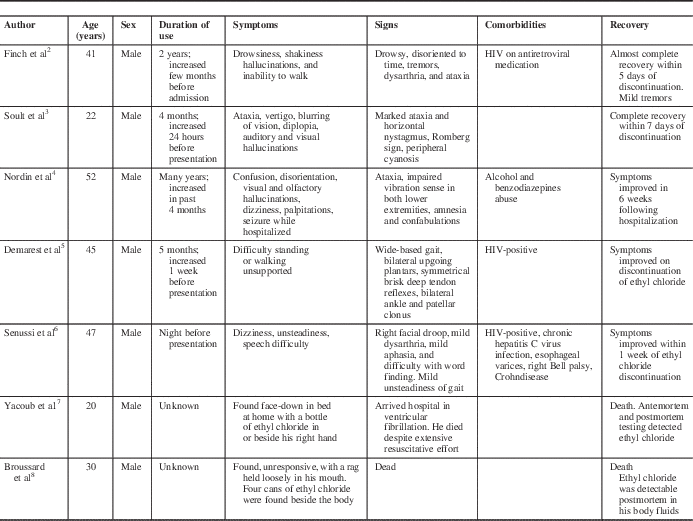A 40-year-old woman presented with unsteady gait and dizziness of 1 month’s duration. The symptoms were of gradual onset and progressive. One day before her presentation, she had transient visual hallucination (seeing animals). She did not have medical or surgical history. She was not on medications. She denied using illicit or recreational drugs. There was no family history suggestive of neurological disorders.
On examination, she was alert with depressed affect. She was dysarthric. She was distracted by transient visual hallucinations. Her Mini-Mental State Examination score was 27/30; the deficits were in following a three-stage command (1/3) and copying crossing pentagons (0/1). She had horizontal nystagmus. Deep tendon reflexes were brisk throughout and pathologically exaggerated at the knees; and she had bilateral patellar and ankle clonus. Plantar responses were flexor bilaterally. Frequent head nodding, and kinetic tremors, worst with intention, of both hands were noted. She had a wide-based, ataxic gait. Her vital signs and general examination were normal.
Her blood work was normal. It included blood counts, biochemistry, vitamins B1 and B12 levels, and serological tests for human immunodeficiency, hepatitis viruses, and Brucella. Connective tissue disease, vasculitis, and celiac disease workup was negative or normal. Thyroid function tests were normal. Anti-Hu antibodies testing was negative. Cerebrospinal fluid cells, protein, sugar, and lactate were within normal ranges. Magnetic resonance imaging scans of the brain and cervical spine were normal. Toxicology screen for lead, arsenic, and mercury was negative. Computed tomography scan of the chest and abdomen was normal. Electrocardiogram was normal. Electroencephalography and electromyography tests were normal.
After the extensive workup, which was normal or negative, she admitted sniffing ethyl chloride spray, which is used as topical anesthetic, for the past 5 months. She has been using four cans per week (each canister has a 100-ml spray that contains 88 g of ethyl chloride).
The patient was assessed by a psychiatrist and met Diagnostic and Statistical Manual of Mental Disorders-5 Diagnostic Criteria for Major Depressive Disorder. Her ataxia and other abnormal neurological signs disappeared after 3 weeks of stopping ethyl chloride use.
Ethyl chloride is a colorless, volatile gas with a strong smell. Ethyl chloride is used as a topical anesthetic.Reference Barceloux and Palmer 1 Its other uses include refrigerant, alkylating agent, electronics head cleaning-solvent, and inhalant to enhance the sexual experience.Reference Barceloux and Palmer 1 It was previously used in general anesthesia but this practice was discontinued because of availability of safer anesthetics.Reference Barceloux and Palmer 1 The literature on ethyl chloride neurotoxicity in clinical practice is limited and mainly derived from case reports. Neurological symptoms have been reported after repeated inhalational exposure to ethyl chloride, and two deaths have been associated with its use. Ethyl chloride lipophilicity results in its rapid absorption from the lungs. It causes central nervous system depression.Reference Barceloux and Palmer 1 The pathophysiology of ethyl chloride neurotoxicity is poorly understood and studies on its biotransformation in humans are lacking.Reference Barceloux and Palmer 1 Findings from toxicokinetics on rodents suggest a few pathways for its metabolism that vary depending on species and ethyl chloride doses.Reference Barceloux and Palmer 1 Management of ethyl chloride toxicity requires early recognition. Ethyl chloride use must be stopped as well as any concomitant use of illicit drugs or toxins. Supportive care and monitoring of patient are the main measures of treatment and recovery will ensue gradually. Psychiatric assessment may play a significant role in the continuing care of the patient. Our patient exhibited predominantly cerebellar ataxia and visual hallucinations. Her neurological signs disappeared 3 weeks after discontinuation of ethyl chloride use. A summary of the previous case reports is depicted in Table 1; in all cases, neurotoxicity was caused by ethyl chloride inhalation.
Table 1 Summary of previous case reports on ethyl chloride neurotoxicity.

Ethyl chloride is a potential drug/substance of abuse and can be easily obtained, given its many uses and availability. Cognitive, cerebellar, and motor neuron dysfunction resulting from ethyl chloride toxicity have been reported, as has death. Patients with ethyl chloride–associated neurotoxicity should undergo full medical and neurological evaluation. Diagnosis of ethyl chloride neurotoxicity may not be readily evident and needs to be considered as part of a broad differential diagnosis.
Disclosures
The authors have nothing to disclose.



